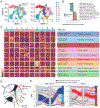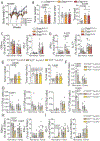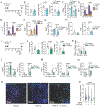TCR-Vγδ usage distinguishes protumor from antitumor intestinal γδ T cell subsets
- PMID: 35857588
- PMCID: PMC9326786
- DOI: 10.1126/science.abj8695
TCR-Vγδ usage distinguishes protumor from antitumor intestinal γδ T cell subsets
Abstract
γδ T cells represent a substantial fraction of intestinal lymphocytes at homeostasis, but they also constitute a major lymphocyte population infiltrating colorectal cancers (CRCs); however, their temporal contribution to CRC development or progression remains unclear. Using human CRC samples and murine CRC models, we found that most γδ T cells in premalignant or nontumor colons exhibit cytotoxic markers, whereas tumor-infiltrating γδ T cells express a protumorigenic profile. These contrasting T cell profiles were associated with distinct T cell receptor (TCR)-Vγδ gene usage in both humans and mice. Longitudinal intersectional genetics and antibody-dependent strategies targeting murine γδ T cells enriched in the epithelium at steady state led to heightened tumor development, whereas targeting γδ subsets that accumulate during CRC resulted in reduced tumor growth. Our results uncover temporal pro- and antitumor roles for γδ T cell subsets.
Figures





Comment in
-
Battle of the γδ T cell subsets in the gut.Trends Cancer. 2022 Nov;8(11):881-883. doi: 10.1016/j.trecan.2022.08.006. Epub 2022 Sep 8. Trends Cancer. 2022. PMID: 36088250
References
-
- Ettersperger J et al., Interleukin-15-Dependent T-Cell-like Innate Intraepithelial Lymphocytes Develop in the Intestine and Transform into Lymphomas in Celiac Disease. Immunity 45, 610–625 (2016). - PubMed
MeSH terms
Substances
Grants and funding
LinkOut - more resources
Full Text Sources
Other Literature Sources
Medical
Molecular Biology Databases

